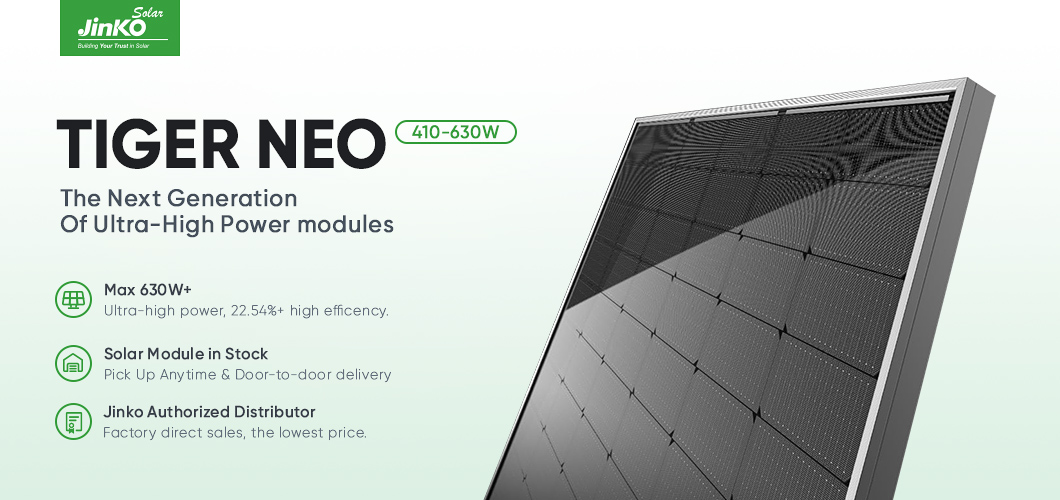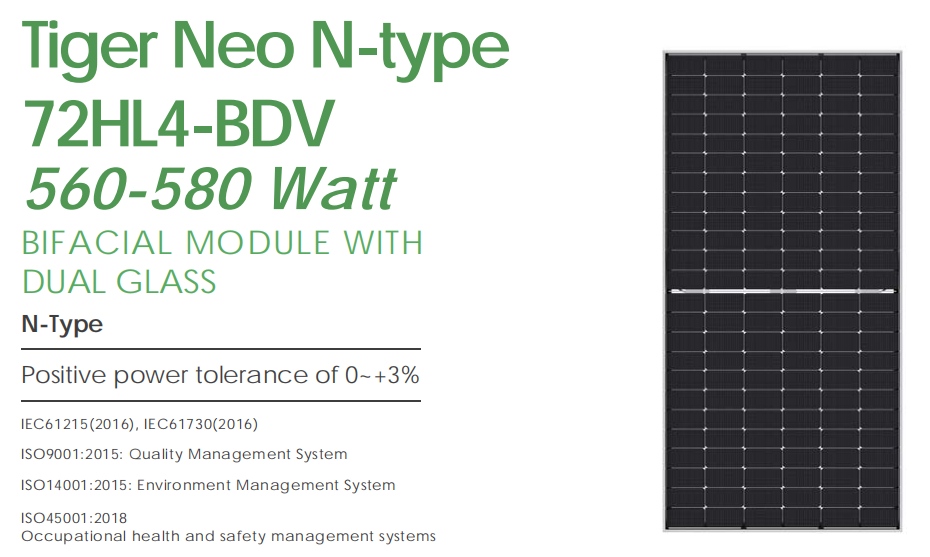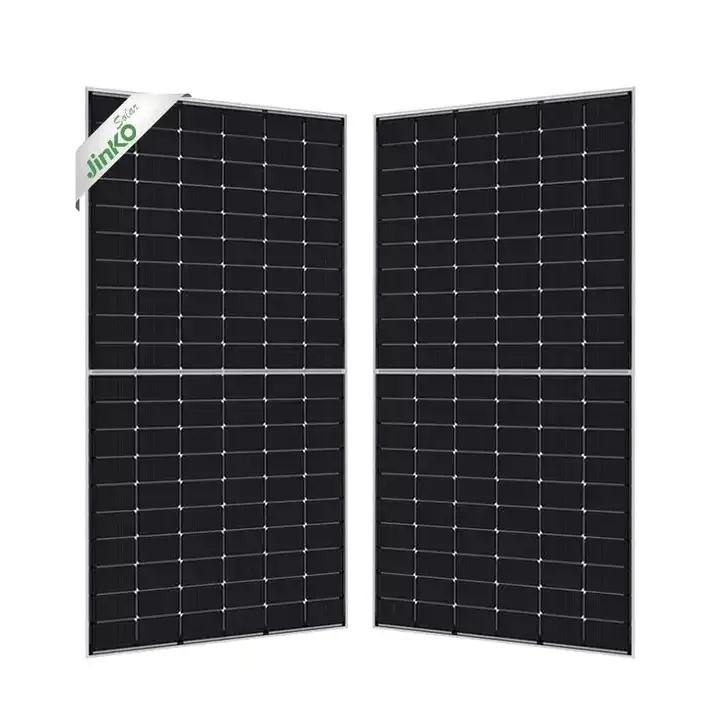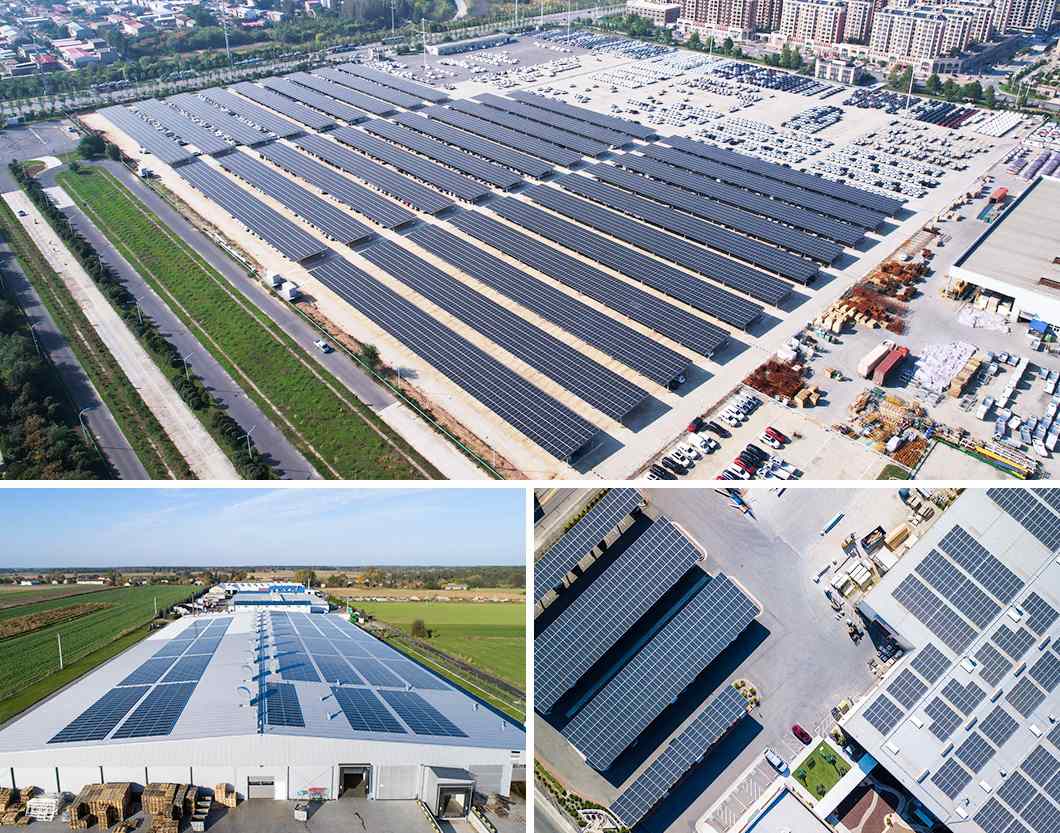The Jinko JKM585-N-72HL4RBDV solar panel offers exceptional power output, efficiency, durability, and reliability, making it an ideal choice for commercial, industrial, and utility-scale solar installations.
Power Range:
575W-585WMax. Efficiency:
22.64%Dimensions of Module L*W*H:
2278*1134*30mmWeight:
32 kgNumber of Cells:
144 (6 * 24)
JinkoSolar is recognized for its high-quality solar products and innovative technologies, making the JKM585-N-72HL4RBDV panel a preferred choice among developers, installers, and project developers globally. Its reliability, performance, and warranty make it a trusted option for solar energy projects of various scales and applications.

Electrical Parameters (STC*)
|
Module model |
JKM575NN-72HL4RBDV |
JKM580NN-72HL4RBDV |
JKM585NN-72HL4RBDV |
|
Maximum Power (Pmax/W) |
575 |
580 |
585 |
|
Open circuit voltage (Voc/V) |
51.27 |
51.47 |
51.67 |
|
Short circuit current (Isc/A) |
14.31 |
14.37 |
14.43 |
|
Peak power voltage (Vmp/V) |
42.44 |
42.59 |
42.74 |
|
Peak power current (Imp/A) |
13.55 |
13.62 |
13.69 |
|
Module Efficiency (%) |
22.26 |
22.45 |
22.64 |
|
Power Output Tolerance (W) |
0~3% |
||
|
Temperature Coefficient of Isc |
+0.046%/°C |
||
|
Temperature Coefficient of Voc |
-0.25%/°C |
||
|
Temperature Coefficient of Pmax |
-0.30%/°C |
||
|
Standard test conditions |
STC:AM1.5 1000W/m² 25℃ |
||

Bifacial solar panels offer several advantages over traditional monofacial panels, primarily due to their ability to capture sunlight from both the front and back surfaces. Here are the key advantages of bifacial solar panels compared to monofacial ones:
--Increased Energy Yield: Bifacial panels can harvest sunlight from both sides, allowing them to capture direct sunlight as well as reflected sunlight from surfaces like the ground or nearby structures. This dual-sided absorption capability leads to a significant increase in energy yield compared to monofacial panels, especially in locations with high albedo or reflective surfaces, such as snow-covered ground or white rooftops.
--Enhanced Efficiency: By utilizing both the front and back surfaces for energy generation, bifacial panels can achieve higher efficiency levels than monofacial panels. This is particularly advantageous in situations where space is limited, as bifacial panels can generate more power per unit area.
--Better Performance in Diffuse Light Conditions: Bifacial panels are more effective at capturing diffuse light, which occurs when sunlight is scattered by particles in the atmosphere or reflected off surfaces. This makes them particularly suitable for locations with cloudy or hazy weather conditions, where direct sunlight may be limited.
--Reduced LID and LeTID Effects: Bifacial panels are less susceptible to Light-Induced Degradation (LID) and Light and Elevated Temperature Induced Degradation (LeTID) compared to monofacial panels. LID and LeTID can cause a decrease in energy output over time in traditional solar panels, but bifacial panels experience less degradation due to their unique cell design and dual-sided illumination.
--Flexibility in Installation: Bifacial panels offer greater flexibility in installation options compared to monofacial panels. They can be installed in both vertical and horizontal orientations, as well as on various mounting structures such as tracking systems or elevated racks. This versatility allows for optimal positioning to maximize energy production based on site-specific conditions.
--Long-Term Cost Savings: While bifacial panels may have a higher upfront cost compared to monofacial panels, their increased energy yield and efficiency often result in long-term cost savings. Higher energy production means faster payback periods and greater returns on investment for solar projects utilizing bifacial technology.
In conclusion, bifacial solar panels offer significant advantages in terms of energy yield, efficiency, performance in diffuse light conditions, durability, installation flexibility, and long-term cost savings compared to traditional monofacial panels. As solar technology continues to evolve, bifacial panels are increasingly becoming a preferred choice for maximizing energy generation in various applications and environments.

Applications of Jinko JKM-N-72HL4RBDV PV Module
Commercial/Industrial: The Jinko JKM585-N-72HL4RBDV is well-suited for commercial and industrial-scale solar installations, offering a high-power solution to meet the energy needs of businesses and enterprises. It enables significant cost savings and enhances sustainability efforts.
Utility-Scale: With its exceptional power output and efficiency, the panel is also suitable for utility-scale solar projects, supporting utilities in generating clean energy on a large scale and advancing renewable energy initiatives.
